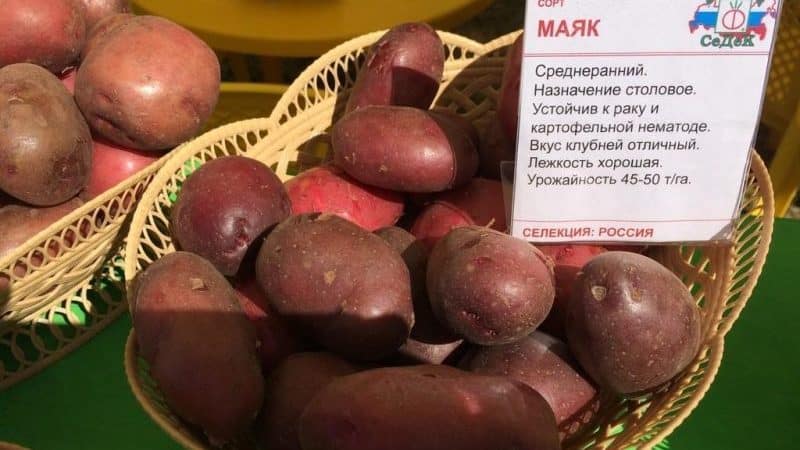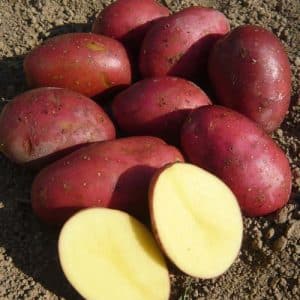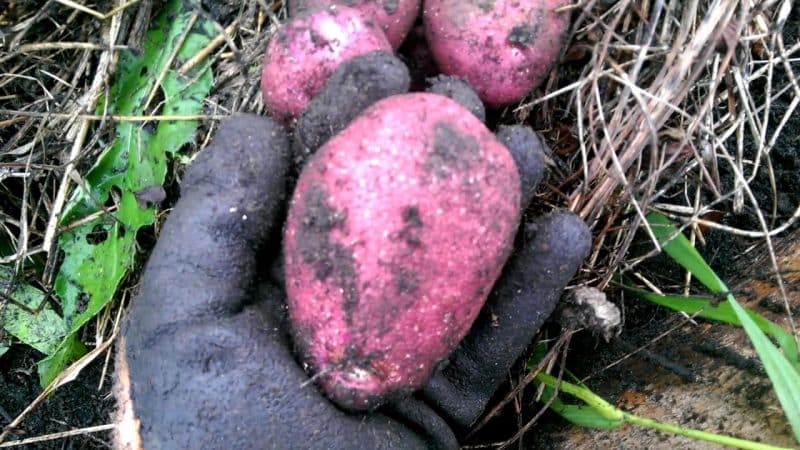Mid-season potato variety "Mayak" with good adaptation to growing conditions
Among the many varieties of potatoes, Mayak stands out. This is a table variety, characterized by adaptation to various climate conditions and soils, productivity and ease of care. Suitable for growing in home gardens and on an industrial scale.
Let's consider a detailed description of the variety and the nuances of its cultivation.
Description
Potato Mayak is a mid-early variety. The bushes are of medium height, the tops are strong, semi-erect. The leaves are dark green, medium size, wavy. The flowers are pale lilac. The bush has a good root system, which allows the formation of 12-18 tubers under each plant.
The variety is easy to adapt to different soils and climatic conditions.

Origin and development
Mayak potatoes are classified as table varieties. It was bred by breeders of the Federal State Budgetary Scientific Institution “Ural Research Institute of Agriculture”.
Recommended for cultivation in the Volga-Vyatka region: Sverdlovsk, Kirov, Nizhny Novgorod regions, Perm Territory, Mari El Republic, Chuvash and Udmurt Republics.
Chemical composition, trace elements and vitamins
The starch content in tubers of the Mayak variety is in the range of 13-17.5%.
Potatoes contain a lot of proteins, carbohydrates, vitamins, micro- and macroelements.
Vitamin content in 100 g of raw potatoes:
- A - 2.83 mcg;
- B1 - 0.13 mg;
- B2 - 0.55 mg;
- B5 - 0.3 mg;
- B6 - 0.28 mg;
- B9 - 0.82 mg;
- C - 22.1 mg;
- E - 0.11 mg;
- RR - 1.32 mg;
- beta-carotene - 0.21 mcg.
Macronutrients:
- calcium - 11.2 mg;
- magnesium - 20 mg;
- sodium - 4.4 mg;
- potassium - 572 mg;
- phosphorus - 47 mg;
- sulfur - 28 mg;
- chlorine - 41 mg.
Microelements:
- iron - 0.89 mg;
- zinc - 0.31 mg;
- iodine - 5.1 mcg;
- copper - 136 mcg;
- manganese - 0.15 mg;
- fluorine - 0.28 mg;
- boron - 0.12 mg;
- aluminum - 0.85 mg.
Calorie content - 74 kcal. Nutritional value per 100 g of product:
- proteins - 2.4 g;
- fats - 0.4 g;
- carbohydrates - 18.1 g;
- starch - 17 g;
- ash - 1 mg;
- water - 76 g;
- dietary fiber - 1.52 g;
- organic acids - 0.24 g.
Ripening time and yield
Mayak is a mid-early variety. 75-85 days pass from the emergence of seedlings to harvest.
Average yields are 115-395 c/ha. The maximum yields were achieved in the Perm region and amounted to 401 c/ha. The yield declared by the developers is 450-500 c/ha.
Disease resistance
The variety is resistant to potato blight, gray and white rot, common scab, wrinkled and striped mosaics, and golden nematode damage. It has average resistance to late blight.
Characteristics of tubers, description of appearance
Mayak's tubers are smooth, even, oval-shaped, with small eyes on the surface. The peel has a reddish tint, the flesh is light yellow, almost white, and does not darken when peeled. The mass of tubers is 100-155 g.
The variety is characterized by multi-tuberism - up to 18 of them are formed on one bush. Potatoes are characterized by good taste. Tubers are slightly boiled and are suitable in boiled form for cutting into salads, baking, frying.
Advantages and disadvantages of the variety
The advantages of the variety include:
- high yield rates;
- good adaptation to different climatic conditions;
- unpretentiousness in cultivation;
- excellent keeping quality.
The disadvantages of the variety are:
- demanding on soil moisture and quality (shows good yield indicators only on fertile soils);
- average resistance to late blight.
Difference from other varieties
Compared to other varieties, Mayak produces a large number of tubers. To obtain high yields, it needs well-prepared, fertile soils.
Features of planting and growing
To grow the variety, choose well-lit areas with fertile soil. The soil should be breathable and loose. In compacted soil, the tubers will become deformed.
Potatoes grow well in slightly acidic or neutral soil. If the acidity of the soil is high, wood ash is added to it when digging.
Preparing for landing
For planting, healthy, smooth, uniform tubers of the same size are selected, without mechanical damage. 20-30 days before landing the tubers are germinating, placing them in clean containers in two layers and placing the containers in a warm room.
Before germination, potatoes are kept in a solution of Fitosporin and a weak blue solution of copper sulfate to prevent the formation of fungal diseases during the growing season. Potatoes with formed sprouts are re-sorted before planting.
Attention! Tubers on which sprouts have not appeared are not suitable for planting.
When the length of the sprouts reaches 1-1.5 cm, planting in open ground begins. To stimulate growth, before planting, planting material is sprayed with a solution of Epin or Zircon (4 drops of the drug per 1 liter of water).
Soil requirements
The variety is grown on any type of soil, but the best results are achieved on well-prepared, fertile, loose soil. A good harvest can be obtained when grown in black soil and turf soil.
To form a large number of tubers, the variety requires soil with the necessary amount of nutrients. Therefore, when digging up a site, add organic matter and minerals to the canopy. fertilizers.
Dates, scheme and rules of planting
Planting of prepared tubers begins at the end of May, after the soil has warmed up to +10°C to a depth of 12-15 cm. Planting dates vary in different areas depending on the onset of heat in the region.
For potato beds, choose a well-lit area. Three weeks before planting, the soil is dug up with the addition of urea and wood ash. When planting, it is useful to pour 100 g of compost into each hole.
Attention! Cow manure is not used during and after planting, as fresh organic matter will cause burns to young shoots.
The holes are placed at a distance of 28-30 cm from each other. A gap of 60-70 cm is left between the rows. The sprouted tubers are carefully placed to a depth of 8-10 cm so as not to damage the sprouts. Sprinkle with loose soil on top.
At first, when the temperature drops at night, the potato beds are covered with film if necessary.
Features of cultivation
To protect against wireworm invasion, potatoes are planted after cereals, legumes, annual grasses, and lupine.
When planting, wide row spacing (60-70 cm) is left for ease of agricultural work, for better lighting and aeration of the bushes.
Important! The depth of planting tubers depends on the composition of the soil.In turf soil and chernozem, tubers are planted to a depth of 6-7 cm, in light sandy loam soils - at 10-12 cm.
Before planting, be sure to check the depth of groundwater. The water level should be at least 75-80 cm from the soil surface.
The soil for planting potatoes begins to be prepared in the fall. All plant residues and weeds are carefully removed, the soil is dug deep, and organic matter and mineral fertilizers are simultaneously applied.
The main nuance in growing this variety is its need for good soil moisture. When watering, it should be taken into account that the need for moisture changes during the growing season.
Mulching beds gives good results. A layer of 6-7 cm will prevent weeds from growing and protect the soil from drying out.
Watering mode
Before emergence, the soil is not moistened, since watering during this period will lead to superficial growth of the root system.
The first watering is carried out when the young tops reach 6-7 cm in height. Water the seedlings with small portions of warm water under each bush. In this case, it is necessary to ensure that the water does not wash the tubers onto the surface. About 2 liters of water are poured under each plant.
Before flowering, potatoes are watered depending on the dryness of the soil, on average - once every 8-9 days.
Reference. If the site has sandy soil, water more often, since such soil dries out faster than turf and black soil.
During the flowering period of the crop, plants require more moisture, since tubers form during this period. If there is a lack of moisture, there will be few tubers and they will not grow to the proper size.
During the formation of tubers, 9-10 liters of water are spent on each bush. Watering is carried out every three days in the morning or evening, preferably by sprinkling.After flowering ends, the volume of liquid is increased to 15 liters.
The last watering is carried out after the lower leaves begin to dry out.
Top dressing
When seedlings appear, the crop is fed with fertilizers containing nitrogen. To do this, use the following composition: 10 g of ammonium nitrate and 10 g of ammonium sulfate per 10 liters of water. Mineral fertilizers are supplemented with organic matter.
Attention! An excess of organic matter leads to the formation of voids in tubers, since the pulp does not have time to form after the active growth of tubers.
During the period of flowering and tuber formation, superphosphate is used in the amount of 30 g per 10 liters of water and potassium nitrate - 25 g per 10 liters of water. Alternate with ash fertilizers.
After flowering ends, the crop is fed with a solution containing 5 g of boric acid, which affects the quality of the fruit. Nitrogen fertilizing is stopped, as it causes rapid growth of tops to the detriment of tubers.
Weeding and hilling
Much attention is paid to clearing the beds of weeds. The weed grows faster than the crop and takes nutrition from the tubers. During weeding, the soil is simultaneously loosened to prevent crust formation and saturate the soil with oxygen.
When loosening, the bushes are hilled, creating a mound that holds the tops in an upright position and makes the bush less spreading.
Reference. It is advisable to resume hilling after watering and rain.
Disease and pest control
The lighthouse is resistant to golden cyst nematode, potato cancer, gray and white rot, common scab, wrinkled and banded mosaics.
The variety has average resistance to late blight. A sign of the disease is the appearance of dark spots on the tops. If left untreated, the disease spreads to the tubers, where the process of rotting begins.
To treat the disease in the initial stage, a solution consisting of potassium permanganate, copper sulfate and boric acid, taken 5 g each and dissolved in 10 liters of water, is used. The product is poured under the root. When the disease spreads, the crop is treated with the fungicides Oxyhom and Ridomil. The preparations are diluted at the rate of 15-20 ml per 10 liters of water and sprayed on the tops.
For prevention, planting material is treated in Fitosporin M.
Fusarium is a fungal disease of potatoes. The first signs of fusarium appear during the flowering period. The tops begin to turn yellow and wither, as fungal mycelium grows in the stems, preventing the movement of nutrients. Affected bushes do not form tubers. Treatment is carried out with the drug “Trichoderma Veride” at the rate of 50 ml per 10 liters of water.
Potato pulp is the wireworm's favorite food. For destruction pest Green manure plants are planted between the rows. The soil is treated with the drug “Topaz”. A 2 ml ampoule of fungicide is dissolved in a bucket of water and the beds are watered.
The Colorado potato beetle destroys all the green mass of the bush. To combat it, the preparations “Commander” and “Iskra” are used: 1 ml of insecticide is dissolved in 5 liters of water and sprayed on the plants.
Difficulties in growing
Since Mayak potatoes are dug up in September, when the period of autumn rains begins, it is not recommended to water the plantings after flowering due to the risk of tubers being damaged by late blight.
The tops of the bushes are high, so they require periodic hilling.
The variety produces a sufficient number of tubers only on fertile soils, so much attention is paid to timely fertilizing.
Harvest and storage

Potatoes planted at the end of May are fully ripened in September.For harvesting, choose dry weather so that it is convenient to remove the potatoes with a pitchfork, since it is difficult to dig in wet soil.
Dug up potatoes dried, sorted and stored. Under proper conditions, the crop retains its presentation and taste until the next season.
How and when to collect
The term is determined by the appearance of the lower leaves on the tops. Yellowing of the foliage indicates that the potatoes are fully ripe. When all the tops turn yellow, harvesting begins.
To avoid damaging the tubers with a shovel, a pitchfork is preferred. The bush is lifted by the tops, the soil is shaken off and transferred to the prepared room.
Storage features and keeping quality of the variety
The collected potatoes are laid out on a dry surface in a dark room for 7-10 days to dry. The air temperature in the room is maintained at +14…+17°C. The room is regularly ventilated.
After drying, the potatoes are sorted. Tubers damaged by rot and dry are thrown away. Potatoes with mechanical damage during digging are selected for consumption first. The good ones place for long-term storage.
A microclimate is created in the vegetable storage with an air temperature of +3...+5°C, humidity 85-90% and regular air circulation. If the recommended conditions are met, the Mayak variety can be stored for 7-8 months. Keeping quality reaches 97%.
Advice from experienced gardeners and reviews about the Mayak variety
Experienced gardeners have noticed that the variety grows and bears fruit better if the first fertilizers are applied during planting, directly into the hole. For this it is better to use humus or ash.
During the germination of tubers, make sure that the light falls evenly on the planting material. To do this, the layers of potatoes are periodically swapped.
Consumer reviews of the Mayak potato variety are mostly positive.
Svetlana, Tambov: «Last season I purchased this potato variety. Planted at the end of May. Despite the fact that I have clay soil on my plot, the potatoes grew large and even. I collected 8-10 tubers under each bush.”
Sergey, Saratov: “The variety was recommended by a neighbor. Like him, I liked the number of tubers in each hole. The taste is good, especially when frying, it doesn’t get overcooked.”
Irina, Tver: “We planted a new potato variety, Mayak. In the fall, the harvest pleased me with its quantity. The root vegetables are smooth, as in the photo, very convenient to clean. Potatoes do not fall apart when cooked; I use them for salads and soups. Very well kept."
Conclusion
Mayak potatoes are in great demand among buyers due to their unpretentiousness and the ability to grow in any climate. The variety attracts with its productivity, keeping quality and resistance to diseases. Gardeners and farmers note the excellent taste and excellent presentation of Mayak potatoes.